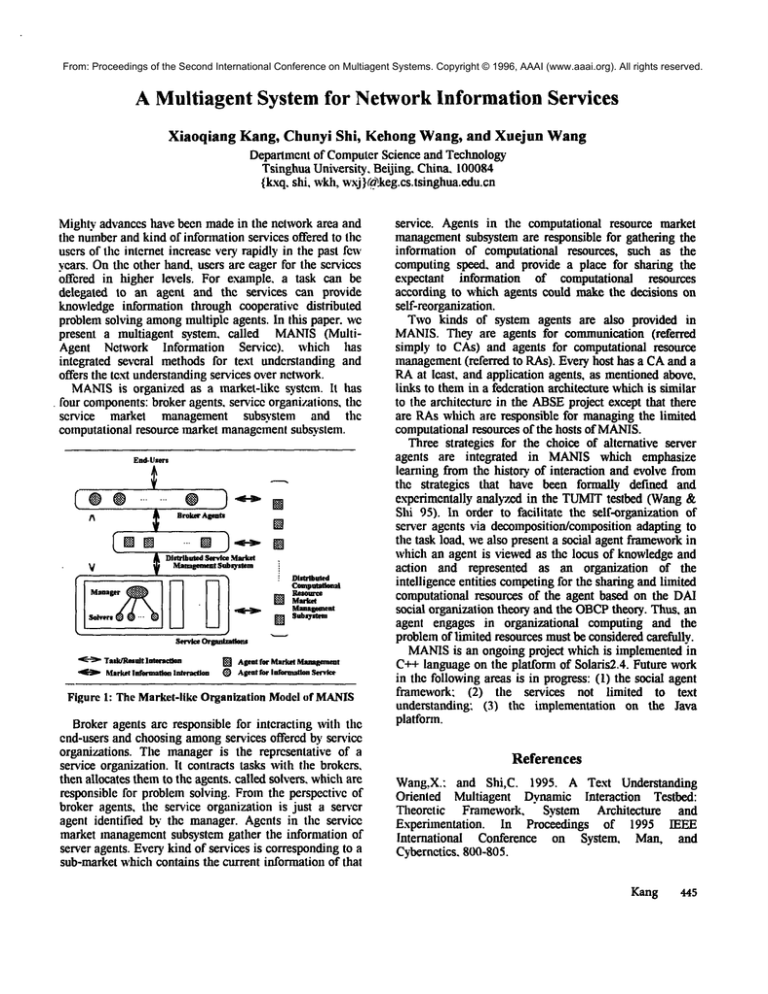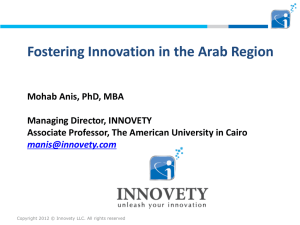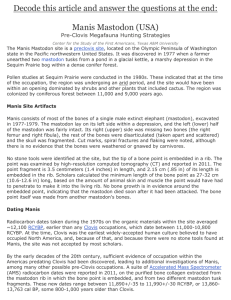
From: Proceedings of the Second International Conference on Multiagent Systems. Copyright © 1996, AAAI (www.aaai.org). All rights reserved.
A Multiagent System for Network Information Services
Xiaoqiang
Kang, Chunyi Shi, Kehong Wang, and Xuejun Wang
Deparlmcntof ComputerScience and Technolo~"
TsinghuaUniversity, Beijing, China, 100084
{kxq,shi, wkh,wxj}(q~.keg.cs.tsinghua.edu.cn
Mightyadvanceshave been madein the networkarea and
tile number
andkind of informationservices offeredto tile
users of tile internet increascver3, rapidlyin the past few
years. Ontile other hand,users are eagerfor the services
offered in higher levels. For example, a task can be
delegated to an agent and the services can provide
knowledgeinformation through cooperative distributed
problemsolving amongmultiple agents. In this paper, we
present a multiagent system, called MANIS
(MultiAgent Network Information Service). which has
integrated sevcral methodsfor text understanding and
offers the text understandingservices over network.
MANIS
is organized as a market-like system. It has
¯ four components:
brokeragents, service organizations,the
service market management subs3"stem and the
computationalresource marketmanagement
subs.vstem.
End-Users
@......
/’l
1
[]
,,
[]
[]
Distributed Saa, lce Mm’ket
ManagemeutSubsystem
Olslrlbuted
Compumflenal
Resource
~ "ra~ult
lmcllea
Marl~lafecmaltm Interat41ea
[]
Agentfor Market Manale~u!
Alient for Infonn~iou.Service
Figurel: TheMarket-likeOrganization
Modelof MANIS
Brokeragents are responsible for interacting with the
end-users and choosingamongservices offered by service
organizations. The manageris the representative of a
service organization.It contracts tasks with the brokers,
then allocates themto the agents, called solvers, whichare
responsible for problemsolving. Fromthe perspective of
broker agents, the service organization is just a server
agent identified by’ the manager.Agentsin the service
market management
subsystemgather the infornmtion of
serveragents. Ever3,kind of services is corresponding
to a
sub-marketwhichcontains the current informationof that
service. Agents in the computational resource market
management
subsystemare responsible for gathering the
information of computational resources, such as the
computingspeed, and provide a place for sharing the
expectant information of computational resources
according to whichagents could makethe decisions on
self-reorganization.
Twokinds of system agents are also provided in
MANIS.They are agents for communication(referred
simply to CAs)and agents for computational resource
management
(referred to RAs).Everyhost has a CAand
RAat least, and application agents, as mentionedabove,
links to themin a federationarchitecture whichis similar
to the architecture in the ABSE
project except that there
are RAswhichare responsible for managingthe limited
computationalresources of the hosts of MANIS.
Three strategies for the choice of alternative server
agents are integrated in MANISwhich emphasize
learning fromthe histoD, of interaction and evolvefrom
the strategies that have been formally defined and
experimentally analyzed in the TUMIT
testbed (Wang
Shi 95). In order to facilitate the self-organization of
server agents via decomposition/composition
adapting to
the task load, wealso present a social agentframework
in
whichan agent is viewedas the locus of knowledgeand
action and represented as an organization of the
intelligence entities competingfor the sharingandlimited
computationalresources of the agent based on the DAI
social organization theory and the OBCP
theory. Thus,an
agent engages in organizational computing and the
problemof limited resourcesmusthe consideredcarefully.
MANIS
is an ongoingproject whichis implementedin
C++languageon the platform of Solaris2.4. Future work
in the followingareas is in progress:(1) the social agent
framework: (2) the services not limited to text
understanding" (3) the implementation on the Java
platform.
References
Wang,X/ and Shi,C. 1995. A Text Understanding
Oriented Multiagent DynamicInteraction Testhed:
Theoretic Framework, System Architecture and
Experimentation.
In Proceedings of 1995 IEEE
International
Conference on System, Man, and
Cybernetics.800-805.
Kang 445



